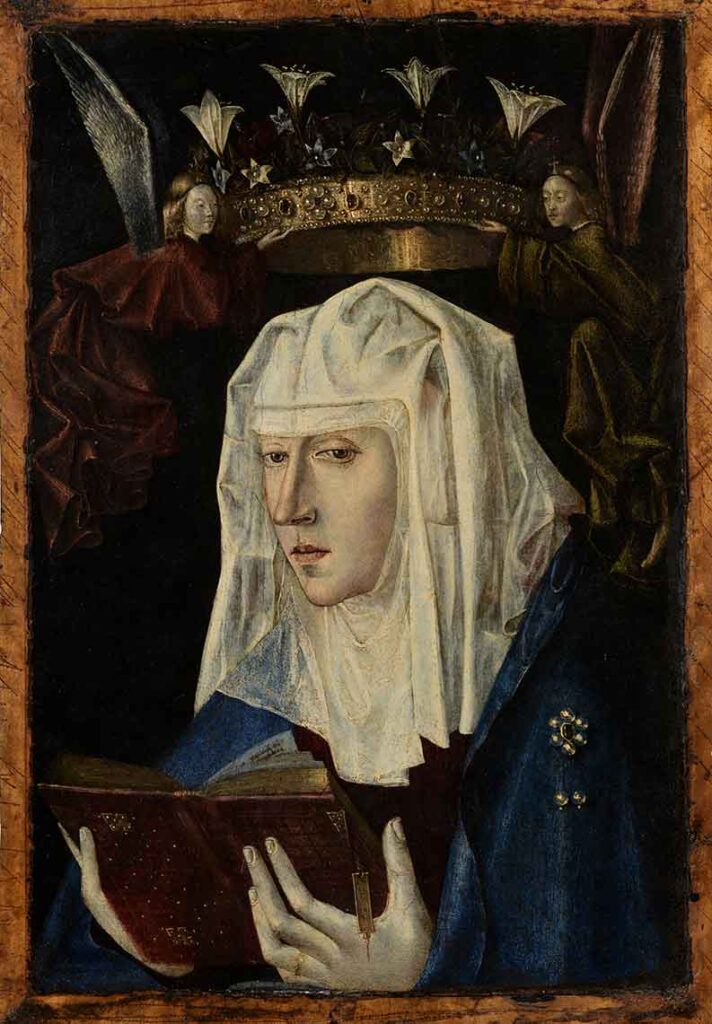The Reading Virgin
attribuito a Antonello da Messina , ca. 1450 - 1460
Description

The work was generously donated to the museum in 2018 by Luciana Forti, in memory of her father Mino. In the painting, the Virgin is depicted three-quarter-length, half-length, with an open book in her hands. Mary, adorned with a white veil covering her head and a blue mantle on which a brooch with pearls and a large ruby “cabochon” in the center stands out, has turned her eyes away from the reading and is facing the viewer; however, her gaze seems lost in the void, as if a sudden thought had struck her. Above, two tiny flying angels hold suspended above her head a golden crown studded with pearls and precious stones from which sprout white lilies, a symbol of chastity and purity, red roses, alluding to the blood spilled by Jesus during the Passion, and campanulas, which refer to mourning. The image thus represents a premonition of Christ’s future sacrifice. The iconography of the work, created for private devotion, derives from Flemish models.
It is found, for example, in the Polyptych of the Mystical Lamb in St. Bavon’s Cathedral in Ghent, executed between 1426 and 1432 by Hubert and Jan van Eyck, in which the Virgin, intent on reading a book, bears on her head a crown from which white lilies and red roses sprout. The two small flying angels crowning Mary also appear in two other depictions closely related to this work and to Antonello da Messina: the Reading Virgin from the Walters Art Museum in Baltimore and the Salting Madonna from the National Gallery in London.
The panel donated to the Poldi Pezzoli Museum was attributed to Antonello da Messina’s early phase by Roberto Longhi in 1944: according to the scholar, it would be one of the earliest works executed by the Messina painter during his training period in southern Italy, under the influence of artists such as the Master of the Triumph of Death in Palermo and Colantonio in Naples. The critical reference has been questioned by other scholars, who consider the work a copy from an original by Antonello, or shift the attribution in the direction of a Valencian painter close to the style of Jacomart Baço, Pere Reixach and Bartolomé Bermejo. However, the high quality of execution, as well as the presence of a very conspicuous retouching in the right hand of the Madonna, would tend to rule out the possibility that it could be a copy.
The poplar wood support, moreover, would seem to be able to refer to an Italian artist-or at least indicate that the work would have been executed in Italy-since oak wood was used in Flanders in the 15th century, and coniferous wood in Catalonia. Technical analyses conducted in recent years have made it possible to identify under the pictorial surface an earlier painting, referable to the same author, which depicts, within Gothic-style architecture, the Archangel Michael with his sword raised above his own head, about to strike the demon lying at his feet.
Data Sheet
Author
Antonello da Messina (attributed to), 1425/1430 - 1479
Date
ca. 1450 - 1460
Material and technique
oil and tempera on panel
Measures
38.7 cm x 26 cm
Acquisition
Luciana Forti donation in memory of her father Mino, 2018
Inventory number
6286
location
Golden Room
The Golden Room is the most important room in the Museum and houses the masterpieces of painting from the Poldi Pezzoli collection. Conceived according to the dictates of the Renaissance style, it was designed to be the hall of honor of Gian Giacomo’s apartment. After the collector’s death, Giuseppe Bertini carried on the work: unfortunately, both the gilded coffered ceiling, the frescoes, painted by Bertini himself, and the damask fabric decorations that lined the walls were destroyed by bombing. The current museographic arrangement dates back to the 1990s. Among the works on display are the Portrait of a Lady attributed to Piero del Pollaiolo and which has become a symbol of the museum, Bellini’s Imago Pietatis, Botticelli’s Lamentation over the Dead Christ, Mantegna’s Madonna and Child, and Piero della Francesca’s Saint Nicholas of Tolentino. The display case separating the Salone Dorato from the Sala degli Stucchi houses the porcelain and majolica collections.
collection
Paintings
The Museum hosts over 300 paintings. Among them, many Italian works from the Renaissance: masterpieces from Tuscany (Botticelli, Piero della Francesca, Pollaiuolo), Lombardy (Luini, Boltraffio, Solario) and Veneto (Bellini, Mantegna). Important is also the group of 18th century Italian painting (Guardi, Canaletto, Tiepolo, Fra Galgario). In the collection, there are mainly portraits and small size paintings.
